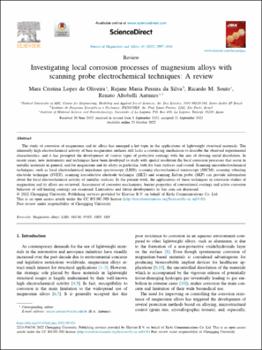Investigating local corrosion processes of magnesium alloys with scanning probe electrochemical techniques: A review.
Fecha
2022Resumen
The study of corrosion of magnesium and its alloys has emerged a hot topic in the applications of lightweight structural materials. The
inherently high electrochemical activity of bare magnesium surfaces still lacks a convincing mechanism to describe the observed experimental
characteristics, and it has prompted the development of various types of protective coatings with the aim of slowing metal dissolution. In
recent years, new instruments and techniques have been developed to study with spatial resolution the local corrosion processes that occur in
metallic materials in general, and for magnesium and its alloys in particular, both for bare surfaces and coated. Scanning microelectrochemical
techniques, such as local electrochemical impedance spectroscopy (LEIS), scanning electrochemical microscopy (SECM), scanning vibrating
electrode technique (SVET), scanning ion-selective electrode technique (SIET) and scanning Kelvin probe (SKP) can provide information
about the local electrochemical activity of metallic surfaces. In the present work, the applications of these techniques in corrosion studies of
magnesium and its alloys are reviewed. Assessment of corrosion mechanisms, barrier properties of conventional coatings and active corrosion
behavior of self-healing coatings are examined. Limitations and future developments in this area are discussed.






